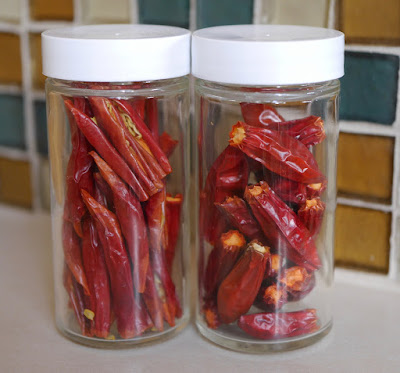 |
| Dried Serrano peppers will spice up your winter recipes! Follow Foods For Long Life on Facebook and Pinterest. Preview my eBook, Health Begins in the Kitchen. |
End of Season Harvests
I'm just wrapping up the summer gardening season. The peppers and eggplant are done producing, the rains are coming, and in about a week, I'll finally be finished canning, freezing and dehydrating - hooray!
I grew a single Serrano pepper plant and while it was growing, I only pulled a few green peppers from it to cook with. So by the time it was ready to harvest, it had almost two pounds of beautiful ripe, red peppers varying in size from one to two inches.
This is probably a life-time's worth of Serrano peppers, but I will dehydrate all of them and give them to whomever wants to spice up their life a bit! Last year I used them to make a lot of hot sauce, some of which I still have. It lasts a very long time in the refrigerator! Here's a recipe for Hot Sauce using Jalapeños and Serrano Peppers.
Serrano peppers, also known as Hidalgo peppers, are spicier than jalapeños but not as spicy as habaneros. To find out how hot your favorite pepper is, check out this Pepper Scale.
Dehydrators
I have enjoyed my Excalibur Dehydrator. When I first bought it, I wondered if I'd ever use it, but I use it all the time. Besides drying fruit and vegetables, I use it to make crackers, fruit leather, and other things. There are many other brands on the market that vary in size and price so pick one that suits your needs.
Dehydrating Serrano Peppers
Place the peppers in a colander and wash them well. Wrap them in a kitchen towel and dry completely.
 |
| Wash in a colander |
Wearing plastic gloves, cut the tops off of each pepper. I sliced the larger serranos in half and left the smaller ones whole but if I had to do it over, I would slice them all as it took two days to dry the whole ones.
Place them on the woven dehydrator sheets without the non-stick solid teflon sheets so that the peppers get maximum air flow. Place the sliced peppers with the seeds facing up so they don't all fall out in your dehydrator.
 |
| Sliced peppers |
 |
| Whole peppers |
Put the dehydrator in a well ventilated room and open the window so the fumes don't get overwhelming.
Place the sheets in the dehydrator and set the temperature to 125 to 135 degrees. The sliced ones will be ready in about 10 hours but may take longer. The whole peppers may take a day or more. Make sure they are fully dried so they will not mold when storing.
 |
| Dried, sliced peppers |
Put the dried peppers in glass jars and store in a cool, dry place.
To cook with the dried peppers, crumble them soups or stir fries. To make cayenne-like pepper, you can grind the dried peppers in a spice grinder and sprinkle on food. However you use these spicy little guys, they can boost your metabolism and help you burn more calories!


































